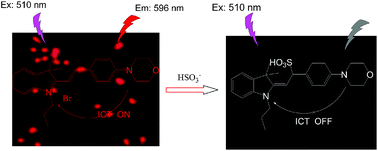An effective biocompatible fluorescent probe for bisulfite detection in aqueous solution, living cells, and mice†
Abstract
Sulfur dioxide, an air pollutant, is easily hydrated to sulfites and bisulfites and extremely harmful to human health. On the other hand, endogenous sulfur dioxide is the fourth gasotransmitter. In view of the above, it is worth developing an effective method for the detection of these compounds. In this paper, a novel colorimetric fluorescent probe (Hcy-Mo), based on hemi-cyanine, for bisulfites is reported. Hcy-Mo shows excellent selectivity for bisulfites over various other species including cysteine, glutathione, CN−, and HS−, and undergoes 1,4-addition reactions at the C-4 atom of the ethylene group. The reaction can be completed in 30 s in a PBS buffer solution and displays high sensitivity (limit of detection is 80 nM) for bisulfites. Test paper experiments show that the probe can be used for bisulfite detection in aqueous solutions. In addition, Hcy-Mo exhibits excellent cell permeability and low cytotoxicity for the successful detection of bisulfites in living MDA-MB-231 cells and in living mice, implying that this probe would be of great benefit to biological researchers for investigating the detailed biological and pharmacological functions of bisulfites in biological systems.



 Please wait while we load your content...
Please wait while we load your content...